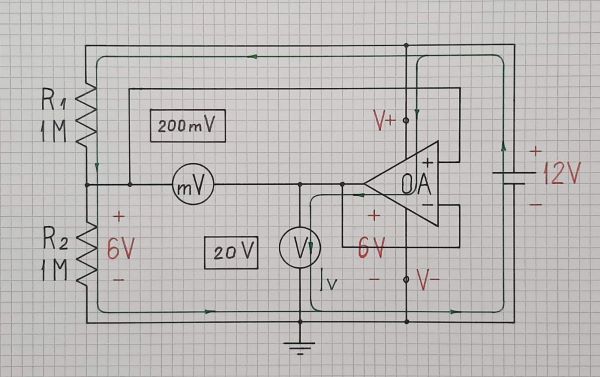What is the basic idea?
First of all, you need to find out what the hell this is all about... what the basic idea is here... and not just in this electrical implementation. Because it is a great idea that we can see all around us and we ourselves constantly realize it in various life situations. That is why I prefer to call it by such figurative names as "principle of life" and "active copying" rather than by the generally accepted "negative feedback".
The basic idea
The problem solved by this idea is simple - to make a quantity Y (Vout here) equal to another quantity X (Vin)... but it is realized in a complex way:
First Y is produced by another (different from the input) source (Vcc), then it is compared by subtraction with X and finally changed to the correct direction until Y = X (Vout = Vin) is reached.
Voltage follower
In the circuit of an op-amp follower, Vout is produced by a properly supplied op-amp, and the two voltages Vout and Vin are subtracted by contrary connecting them in series. The result of this subtraction is a "floating" voltage Vout -Vin that requires an op-amp with a differential input (take a look at this Wikibooks story in which my students "invented", step by step, the op-amp follower and then turned it into an amplifier).
It is interesting that this idea was invented and implemented in electrical form a long time ago - in the 19th century. This made it possible to make an "ideal" voltmeter without any electronic gadgets such as transistors and operational amplifiers. In my story "Ideal" voltmeter (for now, only in Bulgarian), I have told in detail how together with my students I reproduced this famous experiment in the laboratory in order to show the power of this idea. Here are three pictures from the story:

19th century electrical follower ("ideal" voltmeter)

21st century op-amp follower

21st century op-amp follower - conventional circuit diagram
Voltage inverter
In contrast, in the circuit of an op-amp inverter, the two voltages are subtracted by a 2-resistor summing circuit. Its output voltage is referenced to ground; so the op-amp input can be single-ended.
Benefits
The benefit of all this is that the load (next stage) will consume current from Vcc and not from Vin. Vout is a "powerful copy" of Vin, hence the name "buffer" or "booster".
EDIT: What does the op-amp actually do?
(a response to @mohammadsdtmnd's comment)
But when c=a then c=g(b-at) became 0*inf and must be clarified. How OpAm handles (regulates) this subtraction to outcome a replicate?
This topic is often discussed in this forum and good classic explanations are given. But now I will present a new intuitive explanation of the transition process, which came to me a while ago in response to your comment (thanks!).
My insight
Let's define two types of op-amp gain, which we can figuratively call dynamic and static (or, if you prefer, measured and actual).
The dynamic gain is determined by the ratio of the output voltage to the input differential voltage (between the two op-amp inputs) at some point in time. Due to the op-amp inertia (although very small) it changes in time from zero (at the beginning of the transition) to the value of the static gain (at the end of the transition).
The static gain determines the ratio of the output voltage to the input differential voltage (between the two op-amp inputs) at the end of transition. This is the gain given in the op-amp datasheet.
Now we can explain the op-amp behavior. We can imagine it as a control system that (like everything in this world) seeks to reach the equilibrium point. What is it?
The op-amp reaches its state of equilibrium when the dynamic gain equals the static gain.
In other words, when the input voltage changes, the op-amp begins changing its output voltage (and indirectly, its differential input voltage) so that to make the ratio between them equal to the op-amp gain.






